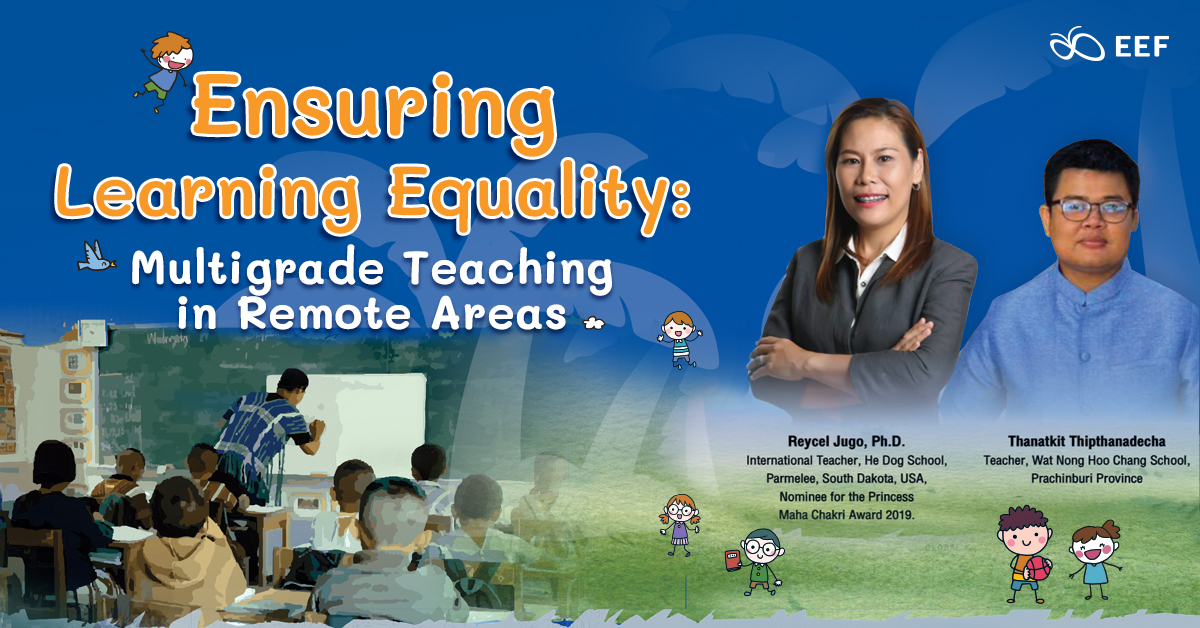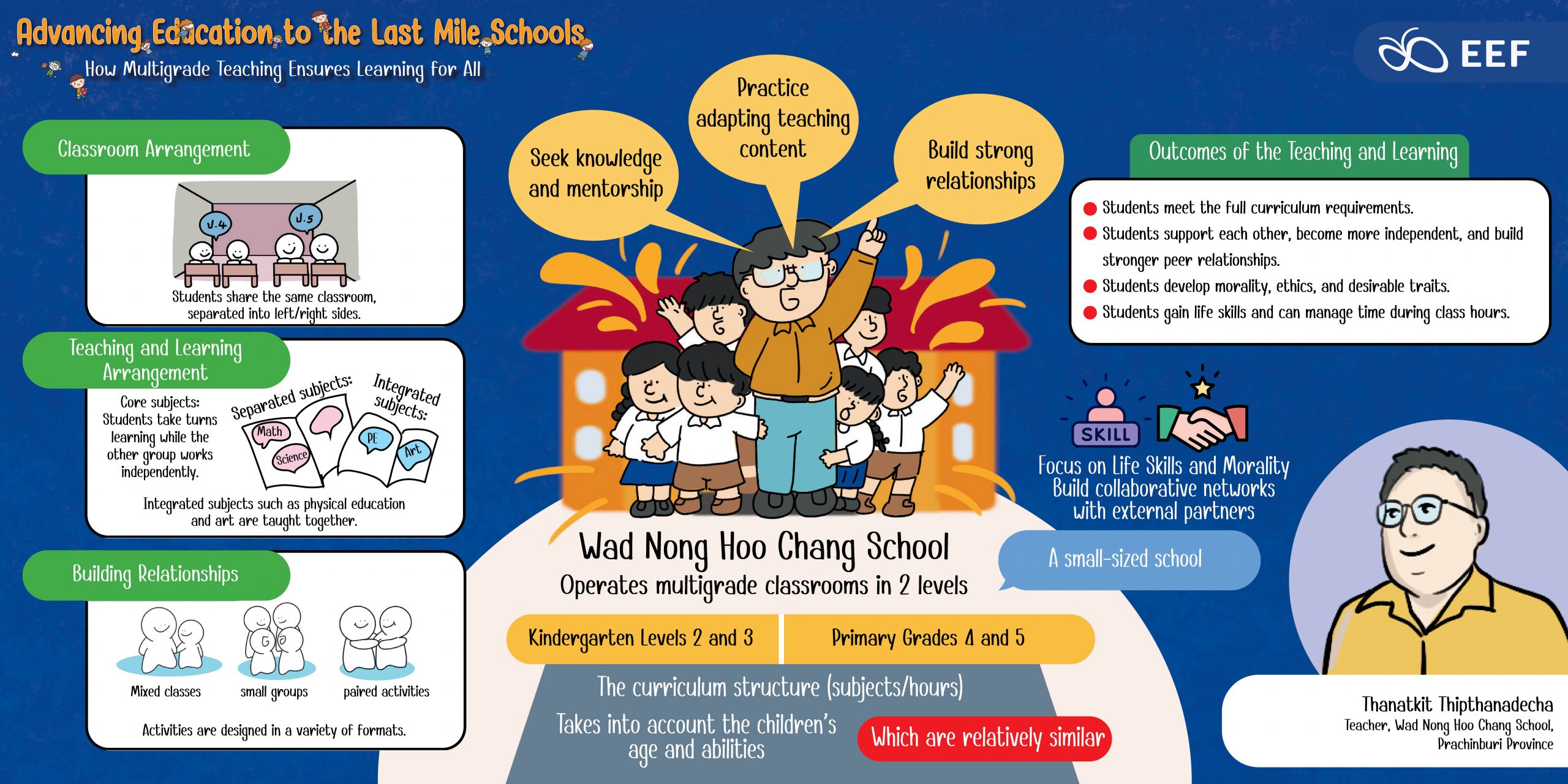
21 May 2025 – As urbanization grows, small rural schools are at risk of being left behind as cities receive more policy support and resources. Multigrade teaching helps ensure children in remote areas still have access to quality education. But what challenges is it facing, and how can it be effectively implemented?
Tilled “Advancing Education to the Last Mile Schools: How Multigrade Teaching Ensures Learning for All” addressed the challenge of multigrade teaching, the principles of multigrade education and how to implement it in real-world settings. Panelists include Dr. Reycel Jugo, International Teacher, He Dog School, Parmelee, South Dakota, USA and Thanakit Thipthanadecha, Teacher of Wad Nongchoochang School, with more than two hundred teachers and educators joining the discussion.
Motivation and Teacher Support to Sustain Impact
Dr. Reycel Jugo, an award-winning multigrade educator from the Philippines and currently a teacher at He Dog School in South Dakota, USA, began her presentation by discussing what motivates a multigrade teacher. She shared that her inspiration comes from witnessing the growth of learners in underprivileged communities.
“For me, it’s not just a job. It’s about meeting students’ needs,” she explained. “In the Philippines, I saw many children living in areas with limited access to education. That’s when I realized I had to bring learning and knowledge into their lives.”
While teacher motivation rooted in purpose is critical, it must be sustained through system-level support. Dr. Reycel emphasized the importance of career development, pre-service and in-service training, access to curriculum resources, and networks for professional collaboration. Community involvement also plays a key role. When schools, local governments, and other stakeholders understand and support multigrade education, they can help strengthen the work of teachers in such settings.

Multigrade Teaching Approaches: The Philippines and Thailand
With over 15 years of experience as a teacher, school administrator, and researcher, Dr. Reycel emphasized that multigrade teaching should go beyond simply delivering content. It should focus equally on the processes of learning and learning outcomes.
“In multigrade classrooms, we need to understand students’ learning styles, adapt our instruction, adjust learning materials, and continuously reflect on and improve our approaches,” she noted. She added that the complexity of multigrade teaching demands a unique skill set. Teachers must simultaneously address diverse learning needs and differentiate instruction according to students’ varying ages and abilities. Limited resources also require teachers to be resourceful and creative in using “what we have.”
Effective classroom management in multigrade settings may involve thematic instruction, flexible groupings, technology integration, and reflective teaching practices. Thailand’s rural schools face similar challenges—such as language barriers, remote geography, limited teaching resources, and high teacher turnover. These issues often result in poor learning experiences and outcomes. These challenges have a negative impact on learning experiences and outcome. Wad Nonghoochang School, a small rural school in Prachinburi Province with only six teachers, has adopted the multigrade approach to confront these issues. The school combines Grade 4 and Grade 5 into one classroom due to the similarity in curriculum content, student ages, and learning capacities.
Thanatkit further explains that because of the student’s socioeconomic background, the school adapts the approach by emphasizing also on life skills and social development. Collaborating with job agencies, it provides a learning opportunity that prepares students for career and real-world challenges rather than focusing solely on academics.
“Our students come from financially disadvantaged backgrounds. Most of them only complete compulsory education, so we focus on practical skills,” said Thanatkit. “The goal is to give students access to quality education, promote positive relationships and behavior, offer career advice, and help them find suitable jobs.” Despite limited resources, the school integrates technology, such as the Distance Learning Television (DLTV) system, into multigrade classrooms. Teachers act as facilitators, supporting students as they learn from remote instruction.

Multigrade Teaching for Equitable Education
Multigrade teaching is proving to be a practical and inclusive solution for addressing educational inequality in rural areas where resources and personnel are limited. Experiences from both Thailand and the Philippines demonstrate that multigrade classrooms require more than simply combining students of different ages into one room. Successful implementation depends on teachers’ motivation, their specialized skill sets, and sustained professional support. With thoughtful integration of creativity, flexibility, and deep understanding of students’ needs, multigrade education can provide meaningful learning opportunities—and a path to success—for children in even the most marginalized communities.


About EEF International Forums:
EEF International Forums serve as a platform for sharing knowledge, experience, views, and innovations related to education and vocational training for disadvantaged children and youths. Since its inception in 2019, the project has successfully organized on-site and online seminars, featuring speakers from various countries. The online events are broadcast via Zoom and Facebook Live, with seminar videos available for later viewing on Facebook and YouTube. For more information about the Equitable Education Fund and the EEF International Forums, please visit https://www.facebook.com/EEFInterForums?mibextid=ZbWKwL and EEF International Forums

